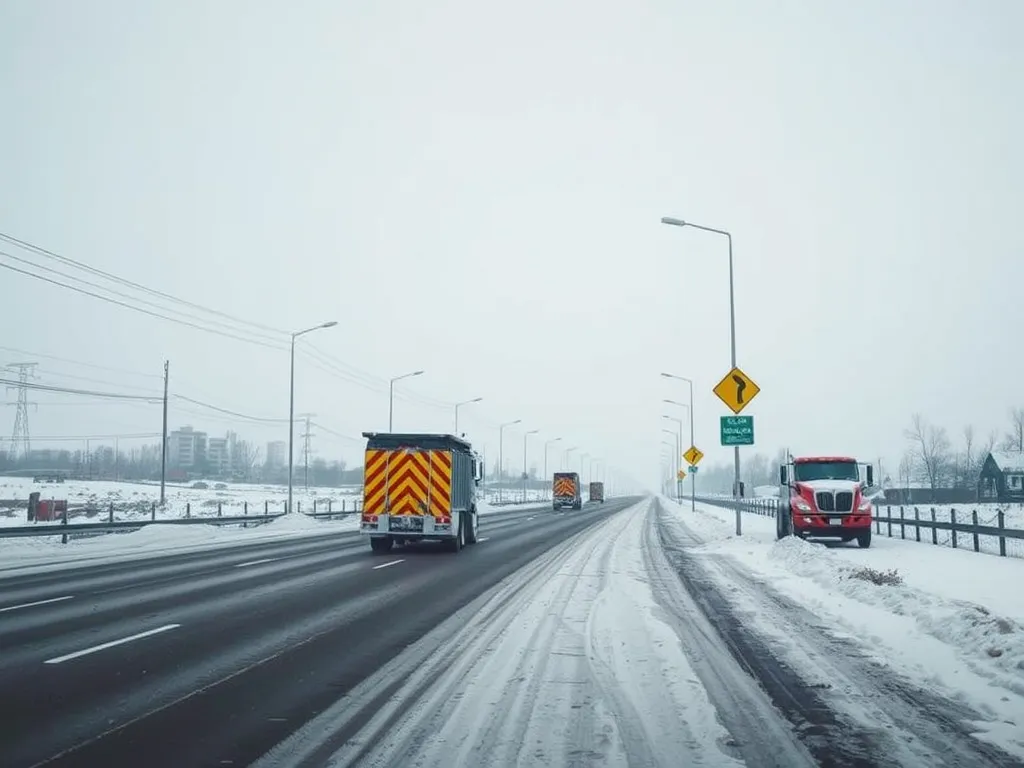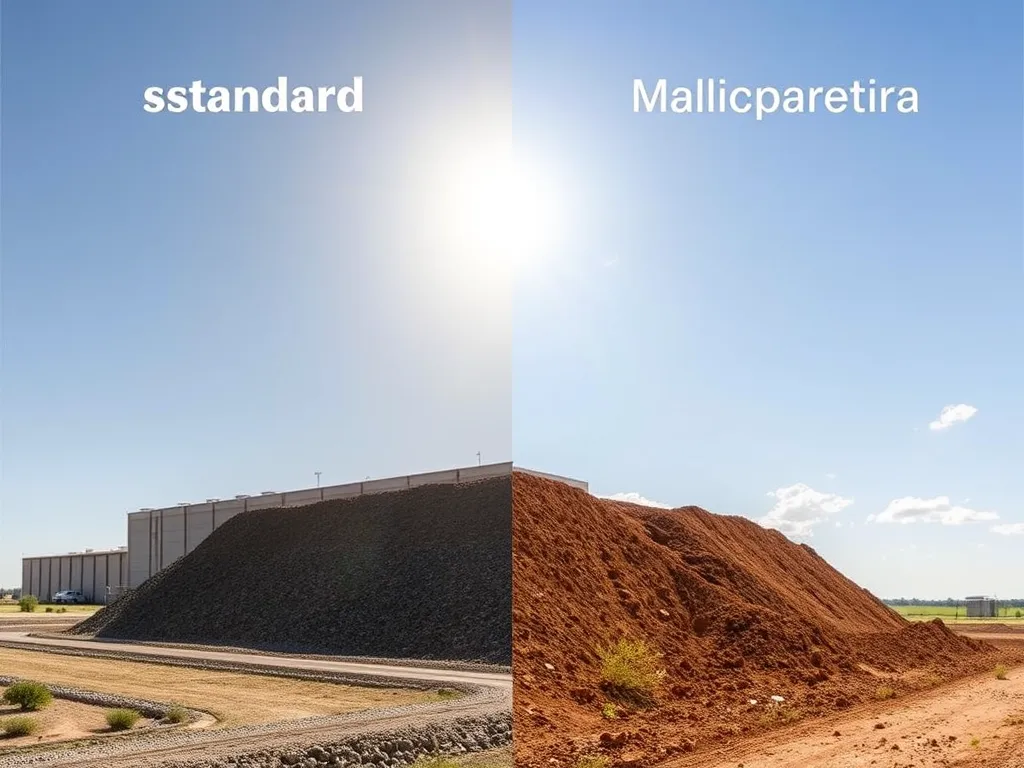Analyzing the Cost-effectiveness Of Asphalt Mixes by Climate
Published on: June 2, 2025 | Last Updated: April 14, 2025
Written By: George Voss
Analyzing asphalt mix cost-effectiveness by climate means matching materials to weather conditions to balance upfront costs with long-term performance. Temperature swings, heavy rainfall, and repeated freezing/thawing directly influence pavement durability and repair frequency. Engineers use climate-specific tools like PG (Performance Grade) binders rated for local temperatures, polymer-modified mixes for heat resistance, and recycled asphalt pavement (RAP) to cut costs by 20-35%. A mix that lasts 15 years in Arizona might fail in 8 years in Maine without proper adjustments.
This article breaks down how climate shapes asphalt costs from installation to maintenance. We compare warm-region solutions like high-stability mixes fighting rutting at 120°F to cold-climate strategies using flexible binders that withstand -30°F cracks. Explore life-cycle cost analysis, regional price differences (think $85/ton Florida polymer blends vs. $72/ton Minnesota winter-grade mixes), and sustainability gains from warm-mix asphalt. Later sections provide actionable criteria for selecting materials by zone and calculating ROI using asphalt calculators.
Contents
- Climate’s Role in Asphalt Mix Performance and Costs
- Methods for Asphalt Mix Cost Analysis by Climate
- Regional Variations in Asphalt Mix Costs
- Optimal Asphalt Mix Selection by Climate Zone
- Sustainability and Environmental Considerations
- Evaluating Cost-effectiveness by Climate Zone
- FAQ: Asphalt Mix Cost-effectiveness by Climate
- Final Words
- Additional Resources for You:
Climate’s Role in Asphalt Mix Performance and Costs
Climate shapes how asphalt behaves over time. It affects both how long pavements last and the total cost to build and fix them. Picking the right mix for local weather cuts repair needs by up to 35%.
Impact Of Climate on Asphalt Pavement Longevity
Heat, cold, rain, and snow change how asphalt wears. Wrong mixes crack, rut, or age faster. This drives up costs for towns, states, and contractors.
Temperature Extremes and Thermal Stress
Hot days soften asphalt. Cold nights make it shrink. These shifts cause cracks. In Phoenix, summer temps over 110°F demand stiffer PG 76-22 binders. In Fargo, PG 58-28 handles -30°F winters. Wrong grades raise repair costs by $8-$12 per square yard.
Moisture and Precipitation Effects
Rain seeps into tiny cracks. It weakens the base layer. Florida’s heavy rains need 4% air voids and rubberized mixes. Without these, potholes form 2x faster. Drainage layers add $1.50 per sq.ft but boost lifespan by 8-12 years.
Warm Climate Challenges
Heat tests asphalt’s strength. Mixes must resist both daily traffic and sun damage.
Rutting and Deformation Risks
Truck tires dig grooves in soft asphalt. Texas uses stone-matrix asphalt (SMA) with 6% binder to stop rutting. SMA costs 15% more than dense-graded mix but lasts twice as long on I-35.
Oxidative Aging in High Temperatures
Sunlight bakes oils out of asphalt. This makes it brittle. Arizona adds polymers to binders, slowing aging. Polymer mixes cost $18-$25 per ton but delay resurfacing by 7-10 years.
Cold Climate Challenges
Freeze cycles and salt use demand flexible, tough mixes.
Freeze-Thaw Cycle Damage
Water in cracks freezes and expands. Minnesota specs 19mm superpave mixes with 30% RAP. These handle 50+ freeze cycles before major cracks. Each thaw cycle without damage saves $4.70 per sq.yd in patching.
Cracking and Brittleness
Cold makes asphalt stiff. Plows chip edges. Maine uses PG 52-34 binders with soy additives. These stay flexible at -15°F, cutting edge cracks by 40%. Additives add $3 per ton but reduce sealant costs by $1.20 annually.
Next, we break down how to weigh these climate factors in asphalt mix cost analysis. Methods like life-cycle tracking and regional price shifts show where to spend now—or pay more later.
Methods for Asphalt Mix Cost Analysis by Climate
Evaluating the financial viability of pavement solutions requires linking material choices to regional weather patterns. Rigorous testing frameworks paired with localized cost tracking reveal how climate shapes both spending and performance.
Life-cycle Cost Evaluation
This approach weighs upfront expenses against future repair needs. For instance, stiffer binders like PG 76-22 (Performance Grade) might cost $8-$12 more per ton in warm zones but prevent rutting repairs costing $45-$60 per square yard over 10 years.
Initial Installation Costs vs. Long-Term Maintenance
High-density mixes with granite aggregates add 15% to installation budgets in freeze-thaw regions. But they curb crack sealing frequency by 40%, saving $3.50 per linear foot yearly. Tools like the Mechanistic-Empirical Pavement Design Guide model these trade-offs using traffic load, temperature swings, and precipitation data.
Climate-Specific Durability Metrics
Lab simulations test mixes under extreme conditions. The Hamburg Wheel Tracking Test subjects samples to 20,000 wheel passes at 122°F to measure rutting. In cold climates, the Thermal Stress Restrained Specimen Test checks cracking thresholds below -22°F. Projects in wet regions prioritize stripping resistance scores above 80% retained strength after moisture exposure.
Key Cost Drivers in Different Climates
Beyond materials, labor availability and weather windows heavily influence budgets. Contractors in snowy states face 30% higher workforce expenses due to compressed paving seasons.
Material Adjustments for Climate Resilience
Polymer-modified binders raise mix prices by 30-40% but extend service life in desert heat by 8-12 years. Recycled asphalt pavement (RAP) incorporation cuts virgin material needs by 25%, yielding 15-25% savings. Warm-mix technologies reduce production temps by 50°F, trimming fuel costs by 18% without compromising density.
Labor and Seasonal Paving Constraints
Northern projects often pay 22% more for crews working in 45-day windows between frost bans. Night paving in urban heat islands adds $120-$180 per ton for lighting and shift premiums. Some states mandate winter stockpiling of specialized mixes, increasing storage fees by $7-$15 per ton monthly.
These frameworks highlight why cookie-cutter cost models fail. Next, we’ll break down how regional pricing fluctuates based on localized weather risks.

Regional Variations in Asphalt Mix Costs
Material choices shift dramatically between warm and cold regions. Climate-driven adjustments directly influence upfront expenses and long-term savings. Let’s break down the numbers.
Cost-effectiveness in Warm Climates
High temperatures demand mixes that resist rutting and aging. Balancing heat resilience with budget requires precise material selection.
Optimal Binder Grades for Heat Resistance
PG 76-22 or PG 82-22 binders dominate warm climates. These Performance Graded (PG) binders soften less at 140°F+ temperatures, reducing rutting risks. Upgrading from standard PG 64-22 adds $2-$4 per ton but extends pavement life by 3-5 years in sunbelt states like Arizona or Texas.
Cost Implications of Polymer-Modified Mixes
Polymer-modified asphalt (PMA) boosts durability but raises initial costs by 20-35%. A 2023 Texas DOT study found PMA overlays last 15 years vs. 10 years for conventional mixes. Savings from delayed repairs often offset higher upfront spending within 7 years.
Cost-effectiveness in Cold Climates
Freeze-thaw cycles and subzero temps demand flexible, crack-resistant designs. Specialty additives and drainage features drive regional cost variations.
Low-Temperature Performance Additives
PG 58-28 or PG 64-34 binders with SBS (styrene-butadiene-styrene) modifiers prevent thermal cracking at -20°F. These mixes cost $8-$15 more per ton than standard grades but reduce crack sealing frequency by 60% in states like Minnesota.
Frost Resistance and Drainage Requirements
Permeable asphalt layers or geotextile fabrics prevent frost heave in snowy regions. Adding 6” of crushed stone base with drainage pipes increases installation costs by $3-$7 per square yard but cuts spring thaw damage repairs by 40%.
With regional costs mapped, the next step involves matching these climate-specific mixes to local project needs. Proper selection balances performance with budget across temperature extremes.
Also See: Asphalt Type Selection Guide: Choosing the Right One
Optimal Asphalt Mix Selection by Climate Zone
Picking the right asphalt mix saves cash and cuts repair needs. Climate zones need unique blends to fight heat waves, deep cold, or wet spells. Let’s break down top picks for warm and cold areas.
Criteria for Warm Climate Mixes
Hot zones demand mixes that hold shape under heat. Skip weak blends. Focus on rut-proof designs and sun-reflect options.
High-Stability Mix Designs
Use stiff binders like PG 76-22 (Performance Grade) and crushed stone. These handle heavy loads at 120°F. Upfront costs rise 12-18%, but rut repairs drop 40%. Add fibers or polymers for extra grip. Track asphalt mix cost analysis to spot long-term wins.
Cost-Benefit of Reflective Coatings
Light-toned coatings slash surface heat by 20-30°F. Less heat means slower aging. Expect $0.50-$1.10 per sq.ft. added cost. But pavement life jumps 35-50% in sun-heavy zones. Pair with high-stability bases for max value.
Criteria for Cold Climate Mixes
Cold calls for bendy blends that won’t crack under ice or salt. Balance freeze-thaw fights with winter upkeep costs.
Flexible Binders for Crack Resistance
PG 58-28 binders stay soft at -20°F. Use 15-22% recycled asphalt pavement (RAP) to boost flex. Costs dip 8-12% vs. new mixes. Cracks drop by half in zones with 50+ freeze-thaw cycles per year.
Cost of Winter Maintenance Integration
Salt and plows harm weak pavements. Add lime or liquid anti-strip agents to guard against salt damage. Adds $3-$5 per ton. But winter repair costs fall 30%. Plan for climate asphalt mix evaluation to weigh short-term spends vs. 10-year savings.
Smart picks today shape both budgets and roads. Next, see how eco-friendly tweaks can trim costs more in harsh climates.

Sustainability and Environmental Considerations
Climate-driven asphalt mix design now integrates eco-friendly practices without sacrificing performance. Balancing material choices with environmental impact unlocks long-term savings while meeting climate demands.
Recycled Materials in Climate-specific Mixes
Recycled Asphalt Pavement (RAP) reuse slashes raw material needs by up to 30%. PG binders modified for regional temps blend seamlessly with RAP, maintaining structural integrity in heat or frost zones.
Cost Savings from Recycled Asphalt Pavement (RAP)
Projects using 25% RAP save $8–$12 per ton versus virgin mixes. Warm climates tolerate higher RAP ratios (30–40%) due to thermal stability, while colder regions cap at 15–20% to prevent brittleness. Lower transport emissions from reduced quarrying add indirect savings.
Emissions Reduction Strategies
Warm-mix asphalt (WMA) tech cuts production temps by 50°F, shrinking fuel use by 20–35%. Lower energy bills offset polymer modifiers needed for extreme climates, yielding net savings of $3–$5 per ton over traditional hot-mix.
Warm-Mix Asphalt Cost Efficiency
WMA extends paving seasons in frost-prone zones by 6–8 weeks, reducing labor downtime. In humid regions, faster compaction curbs moisture damage, trimming maintenance budgets by 12% over 10 years. Hybrid WMA-RAP mixes boost savings further, ideal for transitional climates.
These eco-focused strategies set the stage for evaluating lifetime value across climate zones—where upfront investments meet lasting returns.
Evaluating Cost-effectiveness by Climate Zone
Climate directly shapes asphalt mix performance and long-term value. Evaluating cost-effectiveness requires tools that factor in regional weather patterns, material adjustments, and lifecycle expenses.
Tools for Asphalt Cost Evaluation
Advanced software like AASHTOWare Pavement ME or PAVEXpress integrates climate data with traffic loads and material properties. These tools predict pavement deterioration rates under specific thermal and moisture conditions. For example, PG (Performance-Graded) binder selection tools align asphalt stiffness with local temperature ranges.
Using Asphalt Calculators for Climate-Specific Projects
Online asphalt calculators optimize cost estimates by incorporating climate variables. Input annual freeze-thaw cycles, average summer highs, or rainfall intensity to adjust mix designs. A Phoenix project might specify PG 76-22 binder at $85/ton to resist 120°F heat, while a Minneapolis mix uses PG 58-28 at $78/ton for flexibility at -20°F.
| Climate Zone | Key Adjustment | Cost Impact |
|---|---|---|
| Arid | +8% polymer modifiers | +$12/ton |
| Coastal | +12% RAP (Recycled Asphalt Pavement) | -$9/ton |
| Continental | +5% fibers for crack control | +$7/ton |
Performance Metrics for Climate Adaptation
Key metrics include rut depth progression (warm climates) and crack propagation rates (cold zones). Agencies like FHWA recommend tracking International Roughness Index (IRI) changes tied to thermal cycles. A Minnesota study found high-RAP mixes reduced cold-climate maintenance costs by 18% over 15 years.
Cost per Ton vs. Lifespan Extension
Premium mixes cost more upfront but extend service life. A PG 70-28 polymer-modified mix costs $92/ton versus $78/ton for standard PG 64-22. However, its 22-year lifespan in Texas heat beats conventional 14-year durability, cutting lifecycle costs by 31%.
| Mix Type | Cold Climate Cost/Ton | Warm Climate Cost/Ton | Lifespan (Years) |
|---|---|---|---|
| Standard | $74 | $69 | 12-15 |
| Modified | $89 | $93 | 18-22 |
Next, we explore how sustainability practices like recycled materials further refine cost-climate equations.

FAQ: Asphalt Mix Cost-effectiveness by Climate
How Does Climate Impact Asphalt Mix Costs?
Climate factors influence the durability and longevity of asphalt mixes, leading to variations in both initial installation costs and long-term maintenance expenses. For instance, regions with extreme temperatures may require more expensive materials to handle thermal stress, while areas with heavy rainfall might need designs that prevent water infiltration.
Which Asphalt Mixes Are Best for Extreme Temperatures?
In extreme heat, asphalt mixes with stiffer binders like PG 76-22 are recommended, as they resist rutting and aging better. In contrast, cold climates require flexible mixes with additives to prevent cracking, such as PG 58-28 binders that stay pliable even in severe winter conditions.
Can One Mix Work Effectively in Transitional Climates?
While it is possible for a single mix to perform adequately in transitional climates, it generally involves compromises. It is essential to select a versatile asphalt mix that can accommodate both warm and cold weather conditions, keeping in mind that localized adjustments may still be needed for optimal performance.
Final Words
Analyzing the cost-effectiveness of asphalt mixes in relation to climate is critical for achieving durable and economical roadways. Temperature extremes, moisture content, and the specific challenges presented by warm and cold climates play pivotal roles in not only performance but also long-term costs.
Choosing the right asphalt mix involves evaluating life-cycle costs, considering climate-specific materials, and understanding regional variations. By selecting high-stability designs for warm climates or flexible binders for cold situations, we can enhance pavement longevity while managing costs effectively.
Sustainability also comes into play. Utilizing recycled materials can lower expenses and minimize environmental impact. Warm-mix asphalt technologies further enhance cost efficiency and reduce emissions.
For detailed insights and tools like asphalt calculators tailored for your climate-specific projects, visit Asphalt Calculator USA.
Additional Resources for You:
- National Asphalt Pavement Association (NAPA, Industry Reports & Best Practices)
- Life Cycle Cost Analysis Comparison of Hot Mix Asphalt and Reclaimed Asphalt Pavement: A Case Study
- Global warming impact assessment of asphalt pavement by integrating temporal aspects: A dynamic life cycle assessment perspective – ScienceDirect
- Application of warm mix technology – design and performance characteristics: Review and way forward – ScienceDirect
- A Review of Sustainability in Hot Asphalt Production: Greenhouse Gas Emissions and Energy Consumption


